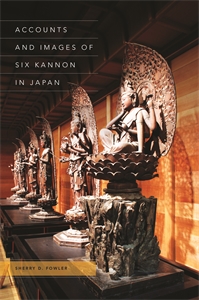Accounts and Images of Six Kannon in Japan
- About the Book
-
Buddhists around the world celebrate the benefits of worshipping Kannon (Avalokiteśvara), a compassionate savior who is one of the most beloved in the Buddhist pantheon. When Kannon appears in multiple manifestations, the deity’s powers are believed to increase to even greater heights. This concept generated several cults throughout history: among the most significant is the cult of the Six Kannon, which began in Japan in the tenth century and remained prominent through the sixteenth century. In this ambitious work, Sherry Fowler examines the development of the Japanese Six Kannon cult, its sculptures and paintings, and its transition to the Thirty-three Kannon cult, which remains active to this day.
An exemplar of Six Kannon imagery is the complete set of life-size wooden sculptures made in 1224 and housed at the Kyoto temple Daihōonji. This set, along with others, is analyzed to demonstrate how Six Kannon worship impacted Buddhist practice. Employing a diachronic approach, Fowler presents case studies beginning in the eleventh century to reinstate a context for sets of Six Kannon, the majority of which have been lost or scattered, and thus illuminates the vibrancy, magnitude, and distribution of the cult and enhances our knowledge of religious image-making in Japan.
Kannon’s role in assisting beings trapped in the six paths of transmigration is a well-documented catalyst for the selection of the number six, but there are other significant themes at work. Six Kannon worship includes significant foci on worldly concerns such as childbirth and animal husbandry, ties between text and image, and numerous correlations with Shinto kami groups of six. While making groups of Kannon visible, Fowler explores the fluidity of numerical deity categorizations and the attempts to quantify the invisible. Moreover, her investigation reveals Kyushu as an especially active site in the history of the Six Kannon cult. Much as Kannon images once functioned to attract worshippers, their presentation in this book will entice contemporary readers to revisit their assumptions about East Asia’s most popular Buddhist deity.
- About the Author(s)
-
Sherry D. Fowler, Author
Sherry D. Fowler is professor of Japanese art history at the University of Kansas.
- Reviews and Endorsements
-
- Accounts and Images of Six Kannon in Japan is a thorough art historical in- vestigation of the Japanese Buddhist cult of Six Kannon that will serve as a resource for senior-level scholars of Japanese art history, religion, and social history. In the process of investigating the Six Kannon tradition, the volume also offers a solid introduction to some key primary texts for understanding the import and function of religious icons in medieval Japan. Written by art historian Sherry D. Fowler, the book undertakes the crucial work of piecing together from what physical and textual traces remain what can no longer be seen of a once flourishing religious tradition centered on multiple manifestations of the bodhisattva Kannon. . . . Fowler’s book is not only a heroic synthesis of diverse materials on Kannon veneration in Japan but also contains a remarkable number of new contributions to the field of art history. . . . I highly recommend this complex volume to scholars in the field of Japanese art history and in religious history.
—Journal of Japanese Studies - This impeccably-researched and beautifully-illustrated volume by Sherry Fowler examines the six manifestations of Kannon, the bodhisattva of compassion, who inspired numerous sculptural sets, painting series, and devotional cults from Japan’s classical Heian period (794-1192) to its early modern Edo period (1600-1868). . . . This magnificent study thus sheds new light on the prevalence and importance of Six Kannon worship in Japan up to the present day. . . . This is a tour-de-force, and a must-read for anyone interested in religion and visual culture, pre-modern Japanese Buddhism, and the above-mentioned topics in the East Asian context. Kannon may often appear with the boon-bestowing gesture (Skt. varada mudrā), but with this work, it is rather Sherry Fowler who has bestowed a boon to all who read it.
—Reading Religion: A Publication of the American Academy of Religion
- Accounts and Images of Six Kannon in Japan is a thorough art historical in- vestigation of the Japanese Buddhist cult of Six Kannon that will serve as a resource for senior-level scholars of Japanese art history, religion, and social history. In the process of investigating the Six Kannon tradition, the volume also offers a solid introduction to some key primary texts for understanding the import and function of religious icons in medieval Japan. Written by art historian Sherry D. Fowler, the book undertakes the crucial work of piecing together from what physical and textual traces remain what can no longer be seen of a once flourishing religious tradition centered on multiple manifestations of the bodhisattva Kannon. . . . Fowler’s book is not only a heroic synthesis of diverse materials on Kannon veneration in Japan but also contains a remarkable number of new contributions to the field of art history. . . . I highly recommend this complex volume to scholars in the field of Japanese art history and in religious history.
- Supporting Resources
-





